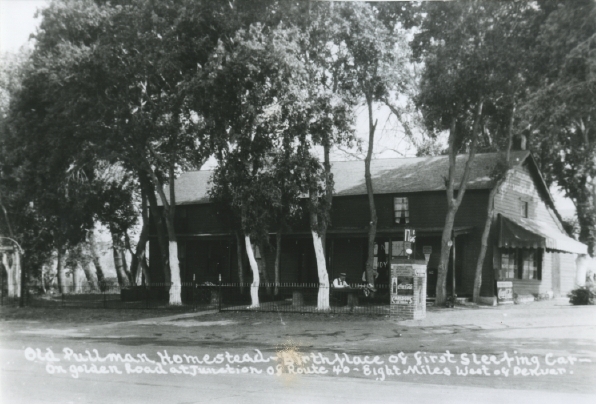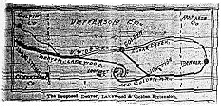
Pullman House, a Survivor of Yesteryear – Painting by Herndon Davis
Published in the Rocky Mountain News on November 24, 1940
Courtesy Denver Art Museum
Throughout the 19th century the Cold Spring Ranch remained a popular stop for many kinds of people. Among the famous persons known to have passed through here include William Frederick “Buffalo Bill” Cody, Gen. Ulysses S. Grant, Gen. Philip Sheridan, Gen. William Tecumseh Sherman, and Isabella Bird. In the 1870s the Johnson family moved out to the ranch, continued to lease it to Martin and built their own frame house nearby. Here Johnson lived the remainder of his years, and continued initially to serve gold seekers, and later visitors, tourists and other patrons who stopped by on the southern route between Golden and Denver. In the 1880s Johnson died, passing the ranch to his son Jonas Jr., nicknamed “Mott.” Like his father, Mott Johnson also ran the Cold Spring Ranch, as well as being a prominent Sheriff in Jefferson County. Somewhere probably during the ownership of the Johnson family a small building was built to house the cold spring, a frame pentagonal shaped gazebo-like structure behind the historic Pullman House.
While Martin still leased the ranch, in 1879, two men with a wagon approached the ranch at night, and inquired of him whether the road ahead was clear. Saying it was, but unable to clearly make out what the men were about, he let them on their way. Later, it was found out, these men were Samuel Woodruff and Joseph Seminole, two outlaws who had just killed wagonmaster Reuben Benton Hayward, and would hide his body beneath a bridge not far on their way from the Cold Spring Ranch. Martin was the first to have seen the wagon without three men in it, as the third had just been killed and was laying unconcealed in the wagon, between Mt. Vernon and Cold Spring Ranch. Had Martin approached the wagon, he most certainly would’ve been in grave danger; as it was he became a key witness to the prosecution. After an interstate manhunt by the Rocky Mountain Detective Agency, Woodruff was intercepted in Big Grove, Iowa, while Seminole was captured with the help of the Indian Police at the Pine Ridge Reservation in South Dakota. The Hayward murderers were brought to Golden, and lynched from a railroad trestle before a trial could take place.
 Denver Republican – 7/31/1895
Denver Republican – 7/31/1895
Proposed Tramway Extension
In 1891 the Denver, Lakewood & Golden railway opened its own tramway line through the Cold Spring Ranch, bringing the latest in public transit (including Pullman-built motors) to a place that once served ox teams going to the gold fields. By this time, the ranch had been pared down to a stock ranch of 600 acres, its western acreage being sold to become the (on paper) Pullman Hights (sic) subdivision. In early 1900 the ranch saw a truly somber moment in history, when the funeral of William C. Rooney (Johnson’s brother-in-law) took place in the Pullman building. Rooney was killed in the line of duty as a guard at Cañon City attempting to stop four prisoners from escaping, and his funeral entourage was made up of 26 carriages of mourners. Later the funeral of Alexander Rooney was also held here.
In 1905 hot cinders from the train ignited dry grass on the ranch next to the tracks, and Johnson and his family barely succeeded in saving the historic Pullman home, their own home and other buildings of the ranch. By this time the Cold Spring Ranch was its own stop along the railway, known as Johnson’s Siding. Around this time the Colorado National Guard, which had been training at a rifle range near South Golden Road, started setting up its first permanent camp on the eastern part of the ranch. Johnson continued subdividing the Cold Spring Ranch and selling off parcels of land for people to build homes, and soon the village of Pleasant View started to take shape.
In 1911 Johnson made the grisly discovery of a skeletal body on the ranch, with bones having washed down in a gulch from South Table Mountain. These proved to be the remains of Maria LaGuardia, an Italian matriarch of Denver who had been lured to the mountain and murdered two years earlier by Angeline Garramone, for her money. In one of the most famous trials in Denver area history, Garramone was sentenced to life in prison for the brutal crime, with friends testifying she had given them threats of death if they ever told of the crime. Much of the remains of LaGuardia may still reside somewhere at Long Gulch, the way where Quaker Street ascends South Table Mountain.
